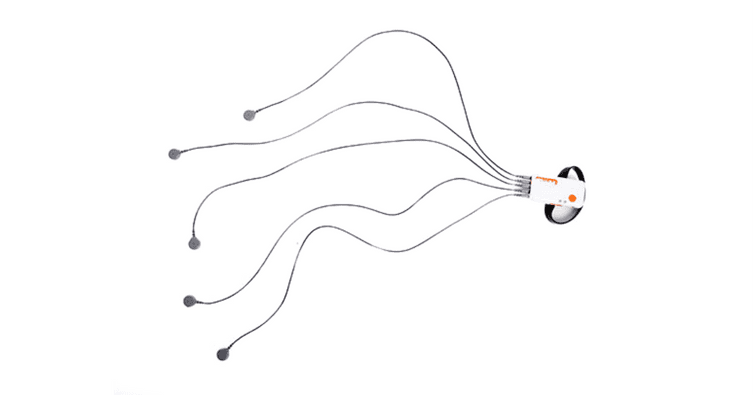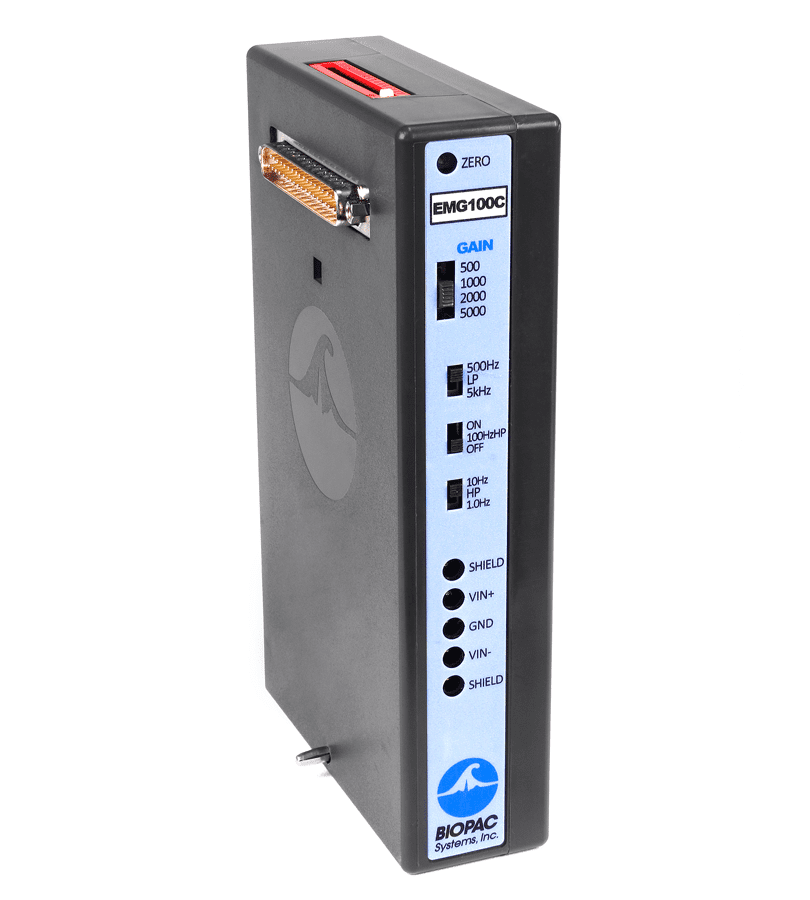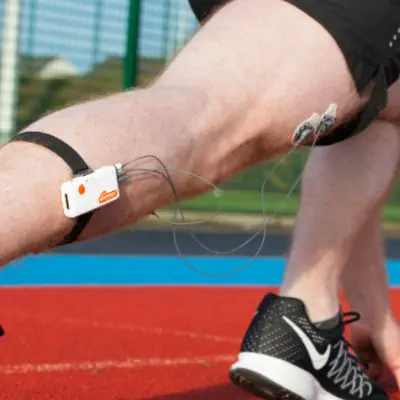Every move we make is accompanied by complex physiological and chemical processes in our bodies. The technology that records this activity is called electromyography (EMG). When a muscle contracts, it generates a burst of electrical activity that cuts through tissue and bone, being easily detected on the surrounding skin areas.
The detection happens through EMG sensors, that “read” the activity triggered by the muscle movement and translate it into data. In this article, we are going to cover some information on EMG sensors and how you can choose one based on your research objectives.
Table of Contents
What are EMG Sensors, and How do they Work?
When hearing about muscle movement, some people might think of complex moves, such as running or doing complicated lifts in the gym. But in fact, any small gesture – such as moving a finger or clenching a fist – produces an electrical signal in your body. EMG sensors scan this activity and determine a potential nerve dysfunction, muscle fatigue, or a simple reaction to a stimulus.
EMG sensors work by having some electrodes (conductive pads) placed on the targeted skin area. For example, if you are interested in seeing how someone’s facial muscles change when they see a certain video, you will have these electrodes placed in specific regions of their face. Every time those muscles get activated, the fibers within them will fire electrical impulses which cause them to contract. This results in electromyographic signals which are recorded by the EMG equipment.
Best EMG Sensor Solutions
When choosing EMG equipment, it is essential to have some criteria in mind, such as sensitivity, and to consider your overall research objectives. In the next paragraphs, you can find some examples of EMG sensors and areas of research where they are best used.
PLUX EMG Sensor
The PLUX EMG sensor is a versatile tool designed for both academic and clinical applications, capturing the electrical activity generated by muscle contractions. Known for its high accuracy and reliability, the PLUX EMG sensor is frequently employed in research involving biomechanics, sports science, rehabilitation, and ergonomics.
This sensor excels in measuring muscle activation levels, assessing nerve conduction, and analyzing movement patterns. Due to its non-invasive and wireless design, it is particularly suited for studies that require freedom of movement, including gait analysis, posture evaluation, and real-time feedback during physical therapy.

Shimmer3 EMG
Known for its clinical uses outside of academia, the Shimmer3 EMG sensor records the electrical activity resulting from muscle contractions and assesses nerve conduction, muscle response in injured tissue, and overall activation level. It is also used in some settings to evaluate and measure the biomechanics of human or animal movement. Given its non-invasive nature, the Shimmer3 EMG sensor is an efficient wireless solution for data on muscles, gait, or posture analysis.

Consensys Base15
Consensys is Shimmer’s first Multi-Sensor Management System. It integrates a software solution that allows you to manage all your subject’s data in a simple and efficient way. With this device, you can configure and capture data from up to 60 sensors at the same time, resulting in simplified storage of recorded data and trial setup. Given its intuitive interface, Consensys can be operated by both technical and non-technical users.
BIOPAC EMG100C
The BIOPAC EMG100C is a compact and versatile electromyogram amplifier ideal for research applications, including facial electromyography (fEMG). It’s capable of amplifying general and skeletal muscle electrical activity, and its integration with the iMotions Software allows for real-time EMG integration and detailed EMG data frequency analysis.
This feature is particularly valuable in fEMG studies for analyzing emotional responses, as it can detect activity in facial muscles like the zygomaticus, orbicularis oculi, and corrugator. The EMG100C’s modular design enables easy system configuration, making it suitable for multi-subject studies. It also offers selectable signal conditioning, enhancing its utility in various scientific research settings.

Factors to Consider When Choosing EMG Sensors
When looking to acquire your electromyography (EMG) sensors, whether for clinical, research, or other applications, it’s crucial to have in mind some essential criteria. Here are some of them.
Number of Channels
Once you are clear on your specific application of the EMG sensor (e.g. research, clinical diagnosis, sports performance, rehabilitation, etc.), consider how many channels you will need. You can do this by asking questions such as:
- How many muscle groups of interest will you have?
- How complex is the task?
- Do you need superior temporal and spatial resolution?
- Do you have any budget constraints?
- How rich will you need the data to be?
The number of channels in the EMG sensors determines the sensor’s ability to record muscle activity from multiple locations at the same time. Therefore, the more channels, the richer the data output you will have at the end. Overall, the number of channels in EMG sensors should align with your research goals, the complexity of the muscle activities you want to study, your budget, and the practicality of data collection and analysis.
Sampling Rate
You should also consider the sampling rate when opting for a particular EMG sensor. This will impact the quality and accuracy of the collected data. In a nutshell, the sampling rate refers to how frequently the EMG sensor records and digitizes muscle activity data per second, typically measured in Hertz (Hz).
An EMG sensor that has a higher sampling rate will provide better temporal resolution, allowing you to capture fast and subtle changes in muscle activity. However, this also comes with some downsides. For example, higher sampling rates generate larger data files, which require more storage space and computational power for processing and analysis. Therefore, you should be aware of the potential trade-off between data quality and storage.
Sensor Type
Another thing to consider is the sensor type. Here, you may want to have certain options in mind, such as:
- Surface EMG: these are non-invasive, comfortable, and easy to use
- Intramuscular, which are invasive and present a higher risk of infection and tissue damage
- Wireless vs wired

When choosing the sensor type, you may also want to consider the comfort and tolerance of the individual (for example, using an invasive sensor with vulnerable people might be difficult in practice), as well as the cost and availability of the sensor.
Compatibility
Lastly, you want to make sure that your EMG sensor is compatible with our data acquisition system or software. Check for compatibility with commonly used platforms and interfaces like Bluetooth, USB, or analog outputs.
Frequently Asked Questions
How does electromyography work?
Electromyography (EMG) records and analyses the electrical activity that results from muscular movement and contraction. It works by placing the electrodes on an area of interest, which then picks up electrical signals that are later amplified into an analog EMG signal. After gathering this data, researchers can gain information about muscle function and the presence of neuromuscular disorders.
Are EMG sensors safe to use?
Electromyography (EMG) sensors are generally safe to use. However, appropriate procedures and precautions need to be followed, especially with invasive sensors that involve a higher risk of tissue damage.
Some potential safety concerns with these sensors are related to the risk of infection, discomfort and pain, allergic reactions (due to electrode material), electrical safety, and training and competence of the technician handling the EMG. Because of these risks, some strict procedures must be followed at all times. These procedures relate to the appropriate disposal procedures for needles and electrodes, the consent and communication with the individual, the cleanliness and sterility of the work environment, ethical concerns, and the proper training of the researcher.
What is the frequency of EMG?
The electrical activity of the muscle is translated into EMG signals. However, not all signals will have the same frequency characteristics. These can vary based on factors such as muscle type, muscle activity level, and the presence of neuromuscular disorders. For example, the frequency range of EMG signals can extend from a few hertz to several hundred hertz, depending on the specific muscle being studied, the force of the contraction, and the measurement equipment’s capabilities.











